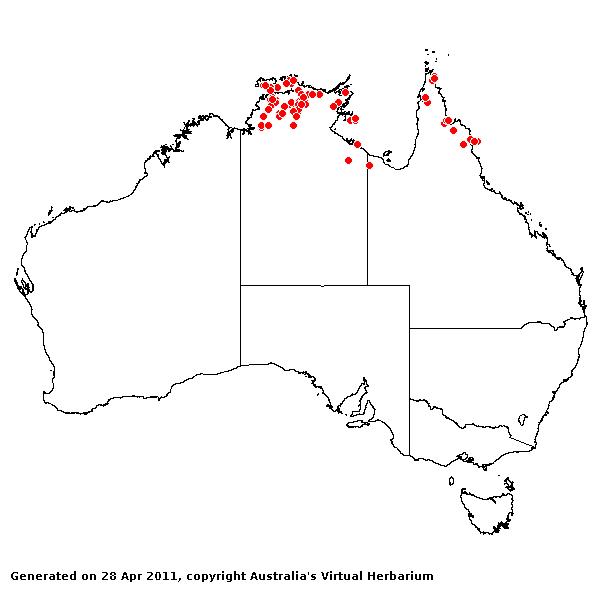Germainia grandiflora (S. T. Blake)
Chaianan. Thai For. Bull. 6: 44 (1972).
Classification.
(GPWG 2001) : Subfamily Panicoideae. Andropogoneae.
Basionym and/or
Replacement Name: Sclerandrium
grandiflorum S. T. Blake, Austral. Journ. Bot. 2: 108 (1954).
Type of Basionym or
Protologue Information: Australia,
Hayes Creek: Blake 16405 .
Recent synonyms:
Sclerandrium grandiflorum.
Key references
(books and floras): [2002] D.Sharp & B.K.Simon, AusGrass, Grasses of
Australia.
Habit.
Perennial. Culms 30–100 cm tall, 4–5 -noded. Lateral branches simple.
Leaf-sheaths glabrous on surface. Ligule a fringed membrane, a ciliate
membrane, 0.5–1 mm long. Leaf-blades erect, 7–30 cm long, 2–5 mm wide.
Leaf-blade surface scabrous, glabrous or indumented.
Inflorescence.
Inflorescence digitate, with ramose branches. Rhachis tough.
Spikelets.
Spikelets pedicelled, 1 in the cluster. Companion spikelets sessile, 1 in the
cluster. Basal sterile spikelets absent or well-developed, 2 in number. Companion
spikelets developed, male, 6.5–12 mm long. Companion spikelet glumes muticous.
Fertile spikelets 2-flowered, the lower floret barren (rarely male), the upper
fertile, comprising 1 basal sterile florets, comprising 1 fertile floret(s),
without rachilla extension, oblong, terete, 4–7 mm long.
Glumes. Glumes
similar, firmer than fertile lemma. Lower glume oblong, coriaceous, without
keels, 3–5 -nerved. Upper glume oblong, 3–6 mm long, coriaceous, without keels,
3 -nerved. Florets. Basal sterile florets 1, barren, without significant
palea. Lemma of lower sterile floret hyaline.
Fertile lemma without
keel. Lemma apex entire, awned, 1 -awned. Median (principal) awn 25–53 mm long
overall, with a twisted column. Palea absent. Lodicules absent or vestigial.
Anthers 2.
Continental
Distribution: Australasia.
Australian
Distribution: Northern Territory, Queensland.
Northern Territory: Darwin &
Gulf. Queensland:
Cook.
Notes.
Grows in sandy soil in wet areas in Eucalyptus and Melaleuca
savannas in tropical N.T. and Qld. Flowers Sept.--Feb. & May--Jul.



